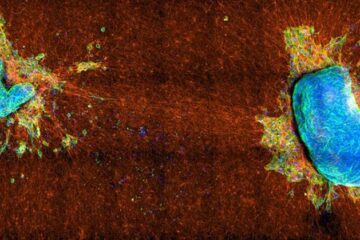Bacteria beat the heat

A team of scientists from the Weizmann Institute's Plant Sciences Department, led by Prof. Avigdor Scherz, has found that a switch in just two amino acids (the building blocks of protein) can make a difference between functioning best at moderate temperatures and being adapted to living in extreme heat. The results of their research, which recently appeared in Nature, might have implications for future attempts to adjust crops to differing climate conditions or improve enzyme efficiency in industrial processes.
The team compared two different kinds of bacteria – one found in moderate environments and the other, an intense-heat lover. Both were photosynthetic (that is, using the sun's energy to create sugars for food). The focus of the research was a reaction that takes place in enzymes in the photosynthetic “reaction center” of the bacterial cell. While gradually raising the surrounding temperature, the scientists timed this reaction to see how reaction rates changed as things heated up.
A general rule for enzyme reactions states that as the heat rises, so does the reaction rate. Contrary to this rule, and the scientist's expectations, both reaction rates peaked at a certain point, and remained steady thereafter. For each enzyme, the peak occurred in the bacteria's “comfort zone.” Further comparisons of the enzymes, which were nearly identical, turned up differences in just two of the hundreds of amino acids making up the enzyme sequence.
When the scientists replaced these two amino acids in the enzyme adapted to the moderate temperatures with those of the heat-loving enzyme, they observed an increase of about 10 degrees in the average temperature at which the reaction rate peaked. Scherz: “This study shows that enzyme efficiency is tuned to the average temperature of the bacterial habitat, rather than the immediate conditions. This may protect the cells from harmful swings in enzyme activity.
We can envision using this knowledge, for instance, to facilitate enzymatic reactions in different applications, enhance crop production in areas subject to extreme temperature changes or create new resources for biofuel production that will not only provide more biomass per acre, but absorb more of the greenhouse gas, carbon dioxide, as well.”
Media Contact
More Information:
http://www.acwis.orgAll latest news from the category: Life Sciences and Chemistry
Articles and reports from the Life Sciences and chemistry area deal with applied and basic research into modern biology, chemistry and human medicine.
Valuable information can be found on a range of life sciences fields including bacteriology, biochemistry, bionics, bioinformatics, biophysics, biotechnology, genetics, geobotany, human biology, marine biology, microbiology, molecular biology, cellular biology, zoology, bioinorganic chemistry, microchemistry and environmental chemistry.
Newest articles

Columbia researchers “unzip” 2D materials with lasers
The new technique can modify the nanostructure of bulk and 2D crystals without a cleanroom or expensive etching equipment. In a new paper published on May 1 in the journal…

Decoding development: mRNA’s role in embryo formation
A new study at Hebrew University reveals insights into mRNA regulation during embryonic development. The study combines single-cell RNA-Seq and metabolic labeling in zebrafish embryos, distinguishing between newly-transcribed and pre-existing…

Study sheds light on cancer cell ‘tug-of-war’
How cancer cells tug against each other determines whether they can migrate elsewhere in the body. Understanding how cancerous cells spread from a primary tumor is important for any number…





















